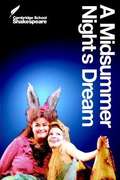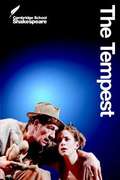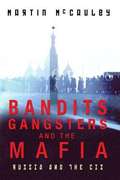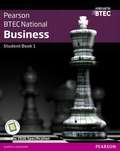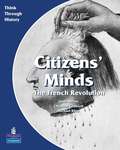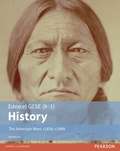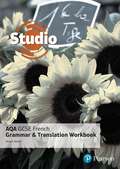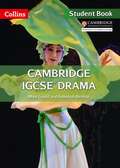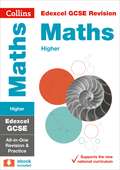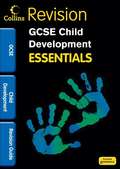- Table View
- List View
Rotation
This diagram shows three triangles; the original triangle and its rotation in two different directions to two new positions. A locator dot and title are shown. These must always be at the top left of the page when the image is the right way up. There is a graph with all four quadrants showing, and the x and y axes ranging from -3 to 3. The x and the y axes intersect at the origin marked by an X. Axes values are positive to the right and to the top of the diagram. Axes values are negative to the left and to the bottom of the diagram. Not all axis division marks are labelled. Some of the braille uses maths code notation. When an object is rotated it stays the same shape but its position and orientation change. The original triangle is in the top left quadrant. The triangle rotated 90? clockwise is to the right. The triangle rotated 180? anticlockwise is shown in the bottom right quadrant. Their path of movement is indicated by curved heavy dashed arc lines. Note the 90? arc in the top right quadrant is broken in the tactile version of the graph to allow a braille label to be clearly read.
Quality control on the production line - Multipage image (UEB contracted)
by Rnib BookshareThis is a multi-page image showing part of a chip production line, set on two pages. There are locator dots shown, which will be at the top left of each page when the images are the right way up. Both sections of the diagram have dashed line image borders. Page one shows a short conveyor belt at the top of the page and the first part of a longer conveyor belt at the bottom right of the page. Due to lack of space the rest of the conveyor belt is shown at the bottom left of page two. Starting from the top left of page one, chips fall from a hopper on to a conveyor belt. Moving to the right, chips are shown dropping down to the second conveyor belt at the bottom of the page and being weighed and bagged. Bags travel along the conveyor belt to the right and past a metal detector and a second weighing machine. The conveyor can be found continuing at the bottom left of page two, it is carrying an open box containing two bags of chips, and to the right of this is a closed box. There is a stack of four boxes beyond the end of the conveyor belt at the bottom right of the page.
The respiration cycle - side view (UEB Contracted)
There are two diagrams on the page, one on the top half and one on the bottom half of the page, they both show the lungs and other contents of the chest in diagrammatic form. They are separated by a thin dashed line. A locator dot and title are shown. These must always be at the top left of the page when the image is the right way up. The top diagram shows the principle of breathing in. The rib and sternum have lifted; the diaphragm is pushing down. This increases the capacity of the chest and air goes in. The bottom diagram shows the principle of breathing out. The rib and sternum have moved downwards; the diaphragm has relaxed and moved up. This decreases the capacity of the chest and air goes out.
Reflection
This diagram shows a triangle reflected on two different mirror lines. A locator dot and title are shown. These must always be at the top left of the page when the image is the right way up. There is a graph with all four quadrants showing, and the x and y axes ranging from -3 to 3. The x and the y axis intersect at the origin O. Positive values are to the right and to the top of the diagram. Negative values are to the left and to the bottom of the diagram. Not all axis division marks are labelled. Some of the braille uses maths code notation. When a shape is reflected it is the same shape but turned over into a new position. The original triangle 1 is in the top left quadrant. Triangle 2 to the right is a reflection in the y-axis. The mirror line is represented by a heavy dashed line which has replaced the normal y axis line in the top part of the diagram. Triangle 3 in the bottom right quadrant, is a reflection in the y = x-axis. This mirror line is also shown as a heavy dashed line. Note the two mirror lines would normally go from one edge of the graph to the other, in this diagram the mirror lines have been shortened to prevent tactile confusion.
Rotation
This diagram shows three triangles; the original triangle and its rotation in two different directions to two new positions. A locator dot and title are shown. These must always be at the top left of the page when the image is the right way up. There is a graph with all four quadrants showing, and the x and y axes ranging from -3 to 3. The x and the y axes intersect at the origin marked by an X. Axes values are positive to the right and to the top of the diagram. Axes values are negative to the left and to the bottom of the diagram. Not all axis division marks are labelled. Some of the braille uses maths code notation. When an object is rotated it stays the same shape but its position and orientation change. The original triangle is in the top left quadrant. The triangle rotated 90? clockwise is to the right. The triangle rotated 180? anticlockwise is shown in the bottom right quadrant. Their path of movement is indicated by curved heavy dashed arc lines. Note the 90? arc in the top right quadrant is broken in the tactile version of the graph to allow a braille label to be clearly read.
The respiration cycle - side view (UEB Uncontracted)
There are two diagrams on the page, one on the top half and one on the bottom half of the page, they both show the lungs and other contents of the chest in diagrammatic form. They are separated by a thin dashed line. A locator dot and title are shown. These must always be at the top left of the page when the image is the right way up. The top diagram shows the principle of breathing in. The rib and sternum have lifted; the diaphragm is pushing down. This increases the capacity of the chest and air goes in. The bottom diagram shows the principle of breathing out. The rib and sternum have moved downwards; the diaphragm has relaxed and moved up. This decreases the capacity of the chest and air goes out.
The respiration cycle - front view (Large Print)
There are two diagrams on the page, one on the top half and one on the bottom half of the page, and they both show the lungs and other contents of the chest in diagrammatic form. They are separated by a thin dashed line. A locator dot and title are shown. These must always be at the top left of the page when the image is the right way up. The top diagram shows the principle of breathing in. The ribs and intercostal muscles have lifted; the diaphragm is pushing down. This increases the capacity of the chest and air goes in. The bottom diagram shows the principle of breathing out. The ribs and intercostal muscles have moved downwards; the diaphragm has relaxed and moved up. This decreases the capacity of the chest, and air goes out.
Spirometer trace (UEB Uncontracted)
by RnibThis is an image of a spirometer trace. It is a multi-page image set on two pages, a key and then the diagram page. A locator dot and title are shown on both pages. These must always be at the top left of the page when the image is the right way up. Key to spirometer trace. The first page shows the abbreviations and textures used on the spirometer diagram page. The abbreviations and samples of the texture are on the left with their description on the right. Spirometer trace. The second page shows a spirometer trace: it is like a graph with the Y axis being lung volume, and the X axis being time. The trace is a thick wavy line with spikes going across the page from left to right. There are two peaks going up towards the top of the page, and two dips going down towards the bottom of the page. The diagram is labelled with abbreviations.
Spirometer trace (Large Print)
by RnibThis is an image of a spirometer trace. It is a multi-page image set on two pages, a key and then the diagram page. A locator dot and title are shown on both pages. These must always be at the top left of the page when the image is the right way up. Key to spirometer trace. The first page shows the abbreviations and textures used on the spirometer diagram page. The abbreviations and samples of the texture are on the left with their description on the right. Spirometer trace. The second page shows a spirometer trace: it is like a graph with the Y axis being lung volume, and the X axis being time. The trace is a thick wavy line with spikes going across the page from left to right. There are two peaks going up towards the top of the page, and two dips going down towards the bottom of the page. The diagram is labelled with abbreviations.
Similarity
This diagram consists of two pairs of similar shapes; the two in the middle of the page are similar and the bottom two are also similar. A locator dot and title are shown. These must always be at the top left of the page when the image is the right way up. Similarity is a type of enlargement. The corresponding sides are in the same ratio - the ratio is the scale factor of the enlargement.
Spirometer trace (UEB Contracted)
by RnibThis is an image of a spirometer trace. It is a multi-page image set on two pages, a key and then the diagram page. A locator dot and title are shown on both pages. These must always be at the top left of the page when the image is the right way up. Key to spirometer trace. The first page shows the abbreviations and textures used on the spirometer diagram page. The abbreviations and samples of the texture are on the left with their description on the right. Spirometer trace. The second page shows a spirometer trace: it is like a graph with the Y axis being lung volume, and the X axis being time. The trace is a thick wavy line with spikes going across the page from left to right. There are two peaks going up towards the top of the page, and two dips going down towards the bottom of the page. The diagram is labelled with abbreviations.
Similarity
This diagram consists of two pairs of similar shapes; the two in the middle of the page are similar and the bottom two are also similar. A locator dot and title are shown. These must always be at the top left of the page when the image is the right way up. Similarity is a type of enlargement. The corresponding sides are in the same ratio - the ratio is the scale factor of the enlargement.
Similarity
This diagram consists of two pairs of similar shapes; the two in the middle of the page are similar and the bottom two are also similar. A locator dot and title are shown. These must always be at the top left of the page when the image is the right way up. Similarity is a type of enlargement. The corresponding sides are in the same ratio - the ratio is the scale factor of the enlargement.
Mitosis (UEB Contracted)
by Rnib BookshareThese pages show interphase before mitosis, four stages of mitosis and daughter cells as a product of mitosis. There is a locator dot shown on each page, which will be at the top left of the page when the image is the correct way up. Mitosis is cell replication where a cell divides to produce two identical daughter cells. Late interphase - This page shows a cell immediately before mitosis starts. The cell is a large rounded shape in the centre of the page. Its nucleus fills the bottom of the cell and two centrioles are in the top of the cell. The twenty three pairs of chromosomes in the nucleus have replicated to form a mass of chromatids (double chromosomes) which are tightly coiled. Note the size of the nucleus and the centrioles in relation to the overall size of the cell are greatly enlarged for clarity. Only some of the chromatin is shown, also for clarity. Mitosis - stage one, Prophas - This page shows the start of mitosis. The cell is in the centre of the page. In the top of the cell the centrioles to the left and right have the mitotic spindle growing between them. The nucleus shows three chromatids, the double chromosomes. In reality in humans there would be twenty three chromatids. Mitosis - stage two, Metaphase - This page shows the completed mitotic spindle with a centriole to the left and right. The nuclear envelope has disappeared. The chromatids have attached themselves to the centre of the spindle by their centromeres in the centre of the image. Mitosis - stage three, Anaphase - This page shows the centromeres have separated. The microtubules of the spindle are retracting to the left and right. Each chromatid has split into single sister chromosomes and are migrating to opposite ends of the spindle to the left and right. Mitosis - stage four, Telophase - This page shows the spindle to left and to the right, nearly gone. The chromosomes have collected together and a new nuclear envelope has formed around them. To the top and bottom centre of the cell the plasma membrane is pinching in and starting to divide the cytoplasm. Identical daughter cells The cell has divided to form two genetically identical cells. Each has a nucleus to the left centre of the cell.
Mitosis (Large Print)
by Rnib BookshareThis image shows the four stages of mitosis over two pages. Page One has two images: 1. A cell has 4 chromosomes, two pairs. 2. Chromosomes are copied. Page Two has two images: 3. Chromosomes form one line down the centre of the cell. 4. One copy of each chromosome moves to the opposite pole of the cell.
A Midsummer Night's Dream (PDF)
by William Shakespeare Linda BuckleThis edition of A Midsummer Night's Dream is part of the groundbreaking Cambridge School Shakespeare series established by Rex Gibson. Remaining faithful to the series' active approach it treats the play as a script to be acted, explored and enjoyed. As well as the complete script of the play, you will find a variety of classroom-tested activities, an eight-page colour section and a selection of notes including information on characters, performance, history and language.
The Tempest (PDF)
by William Shakespeare Rex GibsonThis new edition of The Tempest is part of the established Cambridge School Shakespeare series and has been substantially updated with new and revised activities throughout. Remaining faithful to the series' active approach it treats the play as a script to be acted, explored and enjoyed. As well as the complete script of The Tempest, you will find a variety of classroom-tested activities, an eight-page colour section and an enlarged selection of notes including information on characters, performance, history and language.
Bandits, Gangsters And The Mafia: Russia, The Baltic States And The Cis Since 1991
by Martin MccauleyDuring the 1990s, the "roving bandits", big business or the oligarchs, stole Russia. They gained influence over President Yeltsin and his government, and gradually shaped policy in their own interests. In this first comprehensive account to explain why Russia took the course it did, Martin McCauley examines the period through the prism of government, including Yeltsin's shadow government, and looks at the military, police, security and intelligence services. Relations between Moscow and the regions, industry, agriculture, social policy and foreign policy are also explored. Alternate ISBN 9781317879473
Btec Nationals Business Student Book 1 + Activebook: For The 2016 Specifications (PDF)
by Jenny Phillips Helen Coupland-Smith Catherine Richards Julie Smith Ann SummerscalesEach Student Book and ActiveBook has clearly laid out pages with a range of supportive features to aid learning and teaching: - Getting to know your unit sections ensure learners understand the grading criteria and unit requirements. - Getting ready for assessment sections focus on preparation for external assessment with guidance for learners on what to expect. Hints and tips will help them prepare for assessment and sample answers are provided for a range of question types including, short and long answer questions, all with a supporting commentary. - Pause point features provide opportunities for learners to self-evaluate their learning at regular intervals. Each Pause Point feature gives learners a Hint or Extend option to either revisit and reinforce the topic or encourage independent research or further study skills. - Case study and Theory into practice features enable development of problem-solving skills and place the theory into real-life situations learners could encounter. - Assessment practice features provide scaffolded assessment practice activities that help prepare learners for assessment. Within each assessment practice activity, a Plan, Do and Review section supports learners' formative assessment by making sure they fully understand what they are being asked to do, what their goals are and how to evaluate the task and consider how they could improve. - Dedicated Think future pages provide case studies from the industry, with a focus on aspects of skills development that can be put into practice in a real work environment and further study.
Citizens Minds The French Revolution (PDF)
by Christine Counsell Jamie Byrom Michael RileyBuilds thorough understanding and enjoyment of History through enquiry. Think Through History provides an enthralling enquiry-based approach for 11-14 year olds built around key historical issues and characters.
EdExcel GCSE History: The American West, C1836-c1895 (PDF)
by Rob BircherExam Board: Edexcel Level: GCSE Subject: History First teaching: September 2016 First exams: Summer 2018 Series Editor: Angela Leonard This Student Book: covers the essential content in the new specification in an engaging way, using detailed narrative, sources, timelines, key words, helpful activities and extension material uses the 'Thinking Historically' approach and activities to help develop conceptual understanding of areas such as evidence, interpretations, causation and change, through targeted activities has 'Writing Historically' features that focus on the writing skills most important to historical success. This literacy support uses the proven Grammar for Writing approach used in many English departments includes lots of exam guidance, with practice questions, sources, sample answers and tips to support preparation for GCSE assessments. * These resources have not yet been endorsed. This information is correct as of 31st July 2015, but may be subject to change. You do not have to purchase any resources to deliver our qualification.
Studio AQA GCSE French Grammar And Translation Workbook (PDF)
by Stuart GloverA dedicated workbook to support and consolidate grammar learning and translation skills for AQA GCSE French for first teaching from 2016. Includes: explanations of key grammar points, verb tables, and exercises to embed grammar knowledge translation exercises and strategies for translation both into French and into English a bank of revision translations bringing together grammar and vocabulary learning from throughout the course clear links to the Student Books from the same series.
Cambridge IGCSE Drama Student Book (PDF)
by Mike Gould Rebekah BeattiePrepare for the Cambridge IGCSE in Drama 2016 syllabus with an approach that helps to create a varied, stimulating and enjoyable learning environment that enables students of different confidence and ability levels to flourish. * Be ready to teach the new syllabus (for first examination in June 2016) with this brand new series which has been fully matched to the Cambridge IGCSE® Drama syllabus. * Have full confidence in the content and approach of the series which is written by a team of highly experienced authors, who have over 20 years of teaching experience. * Enable students to learn a range of skills, such as how to build their self-awareness and how to reflect on their performance. This will build their knowledge and self-confidence, which extends beyond the course itself and helps equip them for life. * Know that the series has an international feel in terms of both language used within the text, and plays, scenarios and contexts selected. * Make use of the excellent supporting components of the series which include a range of exciting and engaging scripts from real plays, role plays for warm ups, examples of stimuli for Devised pieces, and still images from productions which show key elements from performances. * Help students monitor their learning using the 'Learning Log' and 'Check your progress' features, where students review, record and evaluate their work. Alternate ISBN 9780008142100
Collins GCSE revision and practice: new 2015 curriculum. All-in-one revision and practice (PDF)
by Collins UK Publishing Staff Collins Gcse StaffThis Maths Revision and Practice range contains clear and accessible explanations of all the GCSE content, with lots of practice opportunities for each topic throughout the book. Based on new research that proves repeated practice is more effective than repeated study, this book is guaranteed to help you achieve the best results. There are clear and concise revision notes for every topic covered in the curriculum, plus seven practice opportunities to ensure the best results. Includes: * quick tests to check understanding * end-of-topic practice questions * topic review questions later in the book * mixed practice questions at the end of the book * free Q&A flashcards to download online * an ebook version of the revision guide * more topic-by-topic practice and a complete exam-style paper in the added workbook Suitable for the new Edexcel Maths GCSE.
Essentials: Revision guide (PDF)
by Judi Sunderland Leann CookeThe student-friendly, uncluttered approach to GCSE revision, guides students through the core Child Development content with succinct revision notes and practice questions that focus on the essential content needed for the exams.

